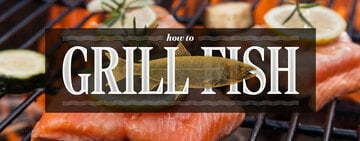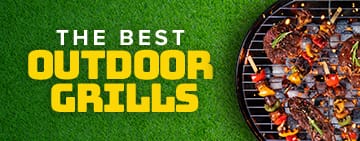
A safe and efficient grilling environment is essential for delivering high-quality meals and protecting your staff, customers, and business. While outdoor grilling brings undeniable flavor and appeal to your menu, it also comes with inherent risks. Whether you're using propane, gas, or charcoal grills, understanding and implementing proper safety protocols can mean the difference between successful service and a dangerous incident. Below, we provide actionable strategies to maintain a secure grilling station, prevent common injuries, and keep your operations running smoothly, all while upholding the highest safety standards.
Shop All Commercial Grills and Griddles- Grilling Safety Tips
- Propane Grill Safety
- Charcoal Grill Safety
- Gas Grill Safety
- How to Put Out a Grill Fire
Grilling Safety Tips
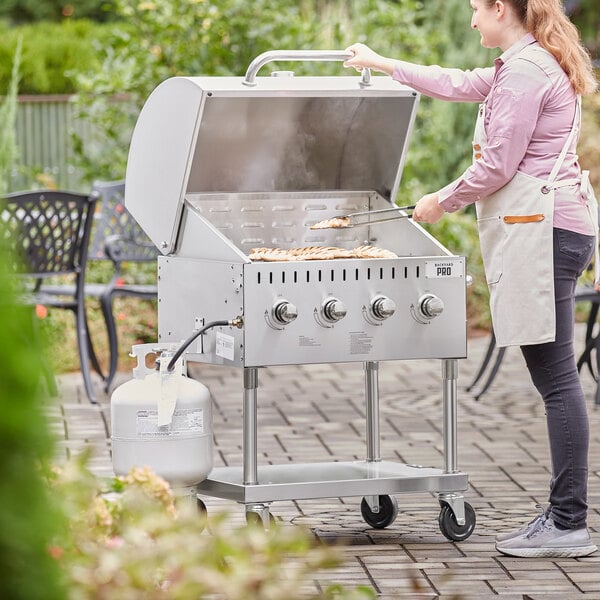
No matter what type of grill you're using, certain fundamental safety practices apply. Following these guidelines reduces fire risks, prevents accidents, and ensures smooth operations, keeping your staff and customers protected. Here are the universal grill safety tips every foodservice professional should follow:
- Only Grill Outdoors: Never use an outdoor grill inside, in enclosed spaces, or under overhangs. Proper ventilation is critical to prevent carbon monoxide buildup.
- Maintain a 3-Foot Safety Zone: Keep grills away from walls, structures, decorations, and high-traffic areas to avoid accidental burns or fires.
- Never Leave the Grill Unattended: A flare-up can happen in seconds. Always have a trained staff member monitoring the grill during operation.
- Inspect and Clean the Grill After Each Use: Check for gas leaks (if applicable), structural damage, and obstructions in burners or vents before firing up the grill. Regular cleaning and maintenance prevent dangerous grease buildup and eliminate other major fire hazards like food residue.
- Keep a Fire Extinguisher Nearby: Verify your fire extinguishers are rated for grease fires (Class B) and that staff knows how to use them in an emergency.
- Avoid Loose Clothing snd Secure Long Hair: Flowing sleeves or dangling accessories can catch fire. Staff should wear fitted, heat-resistant attire.
Propane Grill Safety
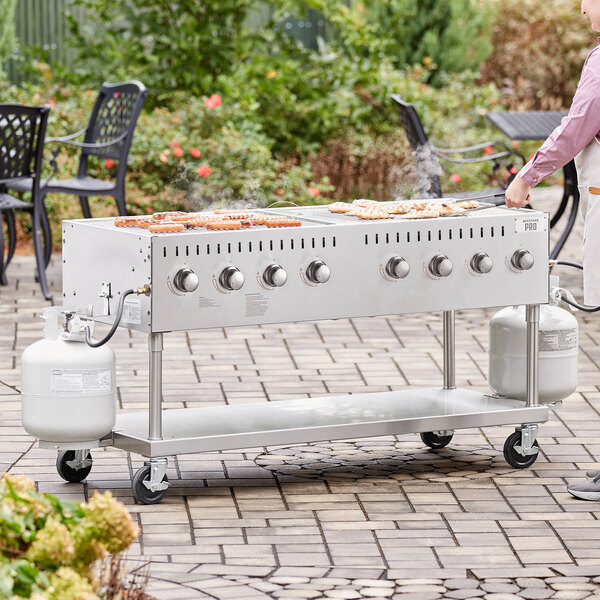
Propane grills are a popular choice in foodservice for their quick heating and precise temperature control, but they come with unique risks that operators must manage. From leak prevention to proper cylinder handling, following propane-specific safety protocols guarantees smooth, hazard-free operations.
- Check for Gas Leaks Before Every Use: Apply a soapy water solution to connections and hoses; if bubbles form, there’s a leak.
- Store Propane Cylinders Properly: Keep spare tanks upright in a well-ventilated area, away from heat sources and direct sunlight.
- Keep the Propane Tank Valve Closed When Not in Use: Even if the grill is off, an open valve can lead to dangerous gas leaks.
- Never Move a Lit or Hot Propane Grill: Wait until the grill is completely cool before relocating it to avoid accidents.
- Ensure Proper Ventilation Around the Grill: Propane combustion produces carbon monoxide; never use in enclosed or poorly ventilated spaces.
- Inspect Hoses and Regulators Regularly: Look for cracks, wear, or damage, and replace faulty parts immediately.
Charcoal Grill Safety

Charcoal grills deliver unmatched smoky flavor, but they require careful handling to prevent fires, burns, and carbon monoxide hazards. Charcoal models present unique challenges, from proper ignition to ash disposal. Mastering these measures aids in both culinary excellence and workplace safety.
- Use Only Approved Charcoal Starters: Never use gasoline, kerosene, or other accelerants that cause explosive flare-ups to light a charcoal grill. Opt for chimney starters or electric starters for safer ignition.
- Allow Proper Ventilation During Use: Charcoal produces significant carbon monoxide; always operate in open, well-ventilated areas, never indoors or under low overhangs.
- Monitor Coal Temperature Carefully: White-hot coals are extremely dangerous. Spread them evenly and adjust airflow to control heat without sudden flare-ups.
- Keep a Spray Bottle of Water Nearby: A spray bottle of water can tame small flare-ups without spreading ash, unlike extinguishers that can disperse embers.
- Never Leave Hot Coals Unattended: Even after cooking, smoldering embers remain a fire risk until completely cold. Assign staff to monitor until safe.
- Avoid Excessive Lighter Fluid: If using fluid, apply only to unlit coals and never after ignition. Let fluid soak in before lighting to prevent dangerous flare-ups.
Gas Grill Safety
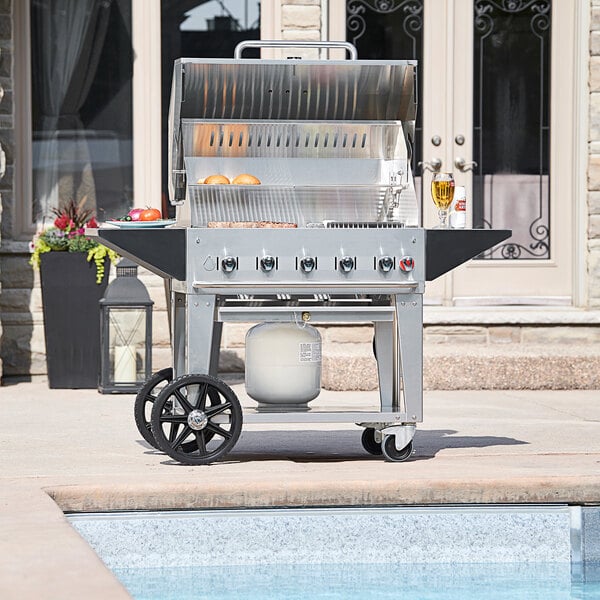
Natural gas grills offer consistent heat and operational efficiency for high-volume foodservice, but their fixed connections and continuous fuel supply demand specialized safety knowledge.
- Inspect Gas Lines: Have licensed technicians check for leaks, corrosion, or damage in permanent gas line connections.
- Clear Burner Ports: Clogged ports cause uneven flames and dangerous gas buildup. Use specialized cleaning tools for maintenance.
- Install Emergency Shutoff Valves: Guarantee accessible shutoff points meet local commercial kitchen regulations for rapid gas cutoff.
- Check Flame Consistency Daily: Blue flames with yellow tips indicate proper combustion; all-yellow flames signal immediate maintenance needs.
- Secure Grill Stability: Permanent installations must withstand heavy use without shifting in a way that stresses gas connections.
- Train Staff on Gas Emergency Procedures: All employees should know evacuation routes and utility shutoff locations in case of major leaks.
How to Put Out a Grill Fire
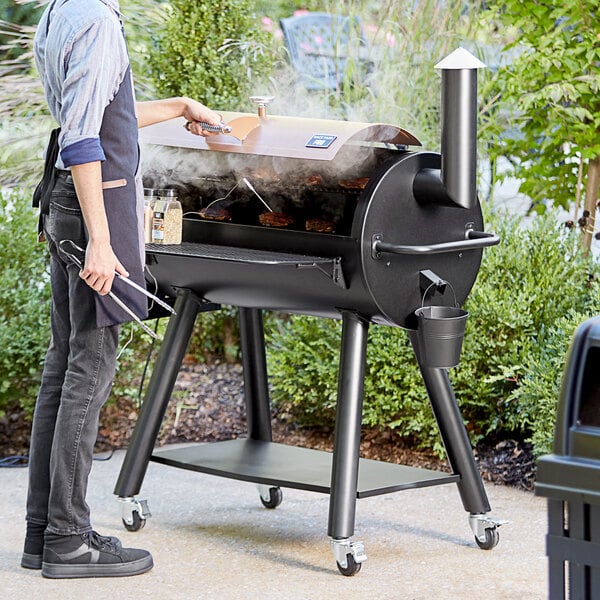
Even with proper precautions, grill fires can occur in busy foodservice environments. Knowing how to respond quickly and effectively to a fire can prevent injuries, property damage, and business interruptions. Follow these emergency procedures to control different types of grill fires safely:
- Cut Oxygen Supply: Immediately close the grill lid and shut off gas/propane valves or choke charcoal airflow.
- Use a Class B/K Fire Extinguisher: Never use water, which spreads grease fires. Keep appropriate extinguishers within 10 feet of all cooking stations.
- Apply Baking Soda or Salt: For small flare-ups, baking soda or salt can smother flames without contaminating food like extinguisher chemicals.
- Never Remove Burning Food: Removing burning food can spread flames. Let items burn out in a contained grill area.
- Evacuate If Fire Spreads: If flames reach gas lines or structural elements, trigger alarms and exit immediately.
How to Prevent a Grill Fire
Prevention remains the most effective fire safety strategy. Implement these operational practices to reduce grill fire risks significantly:
- Conduct Morning Safety Checks: Verify clean drip trays, unobstructed burners, and proper fuel line connections.
- Establish “Cold Zone” Protocols: Maintain 36 inches of clear space around all grills.
- Pre-trim Proteins: Remove excess fat that could drip and cause flare-ups before cooking begins.
- Implement the "2-Minute Rule": Never leave cooking proteins unattended for more than 120 seconds.
- Control Grease Accumulation: Designate staff to care for grates and empty catch pans every 30 minutes during peak service.
- Monitor Heat Distribution: Use infrared thermometers to identify dangerous hot spots developing on grill surfaces.
Grill safety isn’t just a checklist, it’s an ongoing commitment to protecting your team, customers, and business. By understanding the unique risks of each grill type, mastering emergency response, and implementing proactive prevention strategies, you transform safety from a compliance requirement into a competitive advantage. A well-trained staff, rigorous maintenance routines, and clear protocols ensure that your grill service runs smoothly, without compromising on flavor or efficiency.

